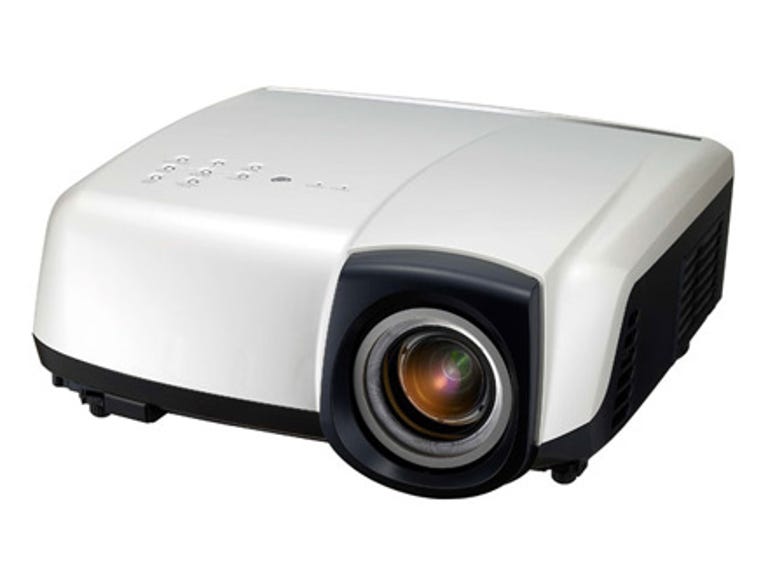 Why You Can Trust CNET
Why You Can Trust CNET Mitsubishi HC6000 review: Mitsubishi HC6000
One of the better performers in the entry-level 1080p projector race, the Mitsubishi HC6000 also benefits from a comprehensive feature set.
Mitsubishi's HC6000 replaces last year's model, the HC5000, as the company's entry-level 1080p home theatre projector. The main improvement is a higher contrast ratio due mainly to an improved black-level performance. It also delivers on its 1080p resolution promise for the most part, with video-processing courtesy of Silicon Optix and a high-quality lens. The feature package is impressive, too, with features usually found only on more expensive projectors. Our biggest complaint is with the inaccuracy of the primary and secondary colours, but we guess you can't have everything. The Mitsubishi's direct competitor in this price range is the Sony VPL-VW60, and we give a slight nod to the Mitsubishi in terms of overall performance.
The Good
The Bad
The Bottom Line
Design
The external appearance of the Mitsubishi HC6000 is fairly basic, with the lens situated at the outer right edge when mounted on the ceiling, or the outer left edge when configured for a floor mount. With a slightly retro look, the lens is set in a squarish base. The projector is finished all in black, which means it will blend in and disappear on dark ceilings. All the connections are located on the rear of the chassis.
The remote control is an intelligently designed unit and all the keys are backlit as soon as one is pressed, making it easier to use in a darkened room. Other than the Menu key, left, right, up, and down rocker keys, and the enter button, there are direct access keys for the Iris, Aspect Ratio, Contrast, Brightness, Colour Temperature selections, all the inputs, and the lens functions. The internal menu system is identical to last year's HC5000 model where it is simple and intuitive to navigate and use.
Features
Electronic controls for horizontal and vertical lens shift, as well as zoom and focus, are the most important features that aid set-up of the HC6000 and are unusual to find at this price range. Since these functions are available electronically from the remote, they're much easier to adjust than with mechanical controls which require you to be at the projector to manipulate.
Other picture controls include a few Gamma modes which are really picture modes with different gamma curves. Cinema is the best preset, while two user modes allow you to adjust the gamma curve yourself, but we don't recommend that unless you know what you are doing.
Selectable colour temperatures are also available, and the User colour temperature is adjustable for those wishing to have the unit professionally calibrated. An Auto Iris feature allows the Iris to open and close automatically depending on how bright the scene is. We recommend you shut this off as it causes both white levels and black levels to shift up and down depending on picture content. Both white and black need to be set correctly and remain constant for best picture performance.
Connectivity is reasonably generous for a front projector. Two HDMI inputs head up the list -- an upgrade from last year's HC5000 which had one HDMI and one DVI input. A single component-video input and a PC socket, which can also be configured for component-video, are also on tap. A single S-Video and composite-video for older legacy sources like VHS decks are also present. Finally, an RS-232 control port and a 12-volt trigger are available as well.
Performance
There is no question that the HC6000 is a significant improvement over last year's HC5000. The biggest area of improvement lies in the greater contrast ratio, due mainly to improved black-level performance. While the Mitsubishi's blacks are much deeper than those of last year's model, some 1-chip 1080p DLP projectors with Dark Chip technology are even better. The LCoS-based JVC DLA-HD100, for example, also has an edge in this all-important performance parameter over the Mitsubishi, although at nearly twice the price.
Excellent colour decoding, good gamma, and accurate greyscale tracking are all part of the package. It is a shame the Mitsubishi's primary and secondary colour accuracy is so far off the mark, taking away from overall colour accuracy in the end. Video-processing comes courtesy of Silicon Optix and its HQV processing scheme, of which there are several levels of quality. De-interlacing proved to be good, and as evidenced by the Silicon Optix HQV test disc in Blu-ray, the HC6000 did a fine job with both video- and film-based HD material.
For real-world testing of black-level performance, we spun the recent Blu-ray release of Blade Runner: The Final Cut. Most of the film is quite dark and the opening sequence is particularly good for checking blacks. L.A.'s futuristic buildings against the night background were reasonably well-rendered, although the blacks weren't quite as inky as the best digital projectors are capable of today. The opening scene of The Departed, also on Blu-ray, was somewhat dark (we think the director is trying to keep you from seeing Jack Nicholson and how old and craggy he really is, since the rest of the film is set 20 or more years into the future). The scene looked good though, with plenty of shadow detail.
This scene also provided a tough test for motion, with a sharp left-to-right pan in the diner when the young girl comes along to serve Jack. Unfortunately, the HC6000 doesn't display a multiple of 24 frames per second from Blu-ray, so there was some judder in film-based material. This scene looked good otherwise, with razor-sharp clarity. Given its price, the HC6000 has a reasonably high-quality lens so images are rendered with commendable clarity when the source is sharp.
